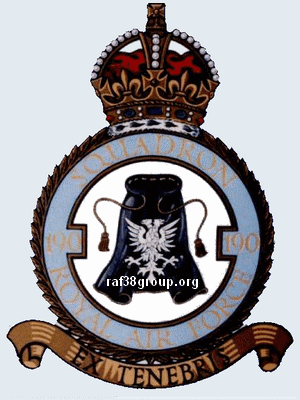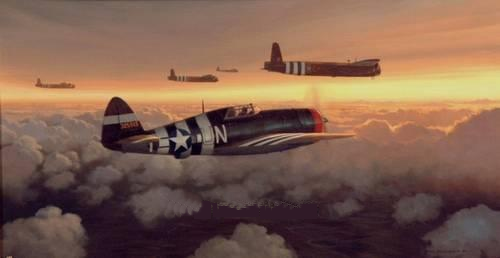
Badge: A cloak charged with a double-headed eagle displayed
Motto: ‘Ex tenebris’ (‘Through darkness’)
HISTORY
No.190 Squadron was formed at Sullom Voe on 17 February 1943 as a Flying Boat Squadron in Coastal Command. Its main task was flying anti-submarine patrols over the North Atlantic until disbanded on 01 January 1944.
On 05 January 1944, No.190 reformed at Leicester East as an Airborne Forces Squadron.
No.190 Squadron Code Letters were ‘G5’ & ‘L9’ on Stirlings and Halifaxes.
In March 1944, No.190 Squadron took part in a number of large-scale glider exercises – It flew 179 glider-towing flights before moving forward to Faiford on 25 March 1944. Then on 31 March 1944 commenced SOE drops out of Tarrant Rushton.
Training and SOE drops continued during 1944 while No.190 Squadron worked up its role in the Normandy landings (Operation ‘OVERLORD’).
At 23:30 hrs on 05 June 1944, No.190 Squadron supplied 23 Stirlings, carrying paratroops of the 5th Paratroop Brigade in phase II of Operation ‘TONGA’ (with each Stirling carrying 20 troops and their equipment). Light flak was encountered but there were no aircraft lost.
Later on 06 June, No.190 supplied 18 more aircraft for glider-towing in Operation ‘MALLARD’, reinforcement of the 5th Paratroop Brigade.
SOE and re-supply missions didn’t stop with ‘D’-Day and some crews left barely they had touched down on 06 June.

In July 1944, No.190 Squadron dropped 93 paratroops and operated on 11 nights, participating in small-scale, very secret operations.
In August 1944, No.190 Squadron, with SOE support activities, had dropped 216 parachutists.
From 17 to 23 September 1944, the Squadron participated in sorties for Operations ‘MARKET’ I, II, III, IV, V & VII. No.190 Squadron flew a total of 98 sorties and had to suffer of heavy losses due to anti-aircraft fire and enemy planes (12 aircraft failed to return and 38 men were killed). On 21 September, 10 Stirlings took off but only 3 returned to base. Of the 7 aircraft which failed to return, one was piloted by the Commanding Officer of the Squadron, Wing Commander G E Harrison DFC, S S(US). Finally, on 23rd, for the last re-supply flights of the Squadron, only 7 aircraft took off (No.190 Squadron had so suffered that it was all it could muster) but fortunately all returned to base after having successfully accomplished their mission.
No.190 Squadron participated also in bombing operations. The first was ordered to Rees on 21 January 1945 and led by the Commanding Officer of the Squadron, Wing Commander R H Bunker DSO, DFC & Bar, who had assumed command after the death of Wing Commander G E Harrison DFC, S S(US) on 21 September 1944. The Rees raid supported Allied Forces in Belgium.
Work continued for SOE during 1945 and now majority of the SOE operations were flown in Scandinavia.
In March 1945, No.190 Squadron made sorties for Operation ‘VARSITY’, the crossing of the Rhine. 27 aircraft airlifted 318 troops from Great Dunmow.
In May 1945, for Operation ‘DOOMSDAY’, No.190 Squadron carried Army units to Norway to disarm the German garrison. On 10 May, during ‘DOOMSDAY’, the Stirlings entered bad weather associated with a front and 2 Stirlings crashed: LJ899 flown by Flying Officer Atkinson and LK297 flown by Squadron Leader Robertson DFC. Aboard LK297 was Air Vice Marshal J.R. Scarlett-Streatfield CBE, AOC No.38 Group, who was killed along with all the others when the Stirling crashed near Oslo. Unfortunately, also on 10 May a third Stirling of No.38 Group crashed during the deployment (LK147 of Flying Officer Breed, No.196 Squadron).
After a period of general transport duties with Stirlings (until June 1945) and now Halifaxes, No.190 Squadron was renumbered No.295 Squadron on 21 January 1946.

Aircraft Strengths
11 July 1944: 39 Stirlings on strength
12 September 1944: 36 Stirlings on strength

Commanding Officers
25 January 1944 Wing Commander G.E. HARRISON DFC, S S(US) (KiA, 21 September 1944)
S S(US): Silver Star – United States of America
02 October 1944 Wing Commander R.H. BUNKER DSO, DFC & Bar (KiFA, 20 April 1945, Odiham)
24 April 1945 Wing Commander G.H. BRIGGS DFC
01 July 1945 Wing Commander L.C. BARTRAM

Date / Base / Aircraft
17 February 1943 Squadron Formed at Sullom Voe Shetland in No.18 Group Coastal Command – nucleus from No.210 Squadron Coastal Command
17 February 1943 / Sullom Voe Shetland (det Reykjavik) / Catalina IB
October 1943 / Sullom Voe Shetland (det Reykjavik) / Catalina IB, Catalina IV
01 January 1944 Squadron Disbanded (renumbered as No. 210 Squadron)
05 January 1944 Squadron Reformed at Leicester East Leicestershire in No.38 Group
January 1944 / Leicester East Leicestershire / Stirling IV
25 March 1944 / Fairford Glostershire / Stirling IV
14 October 1944 / Great Dunmow Essex / Stirling IV
May 1945 / Great Dunmow Essex / Stirling IV, Halifax III, Halifax VII
June 1945 / Great Dunmow Essex / Halifax III, Halifax VII
21 January 1946 Squadron Disbanded (renumbered as No.295 Squadron at Tarrant Rushton)
Next page: 196 Squadron

